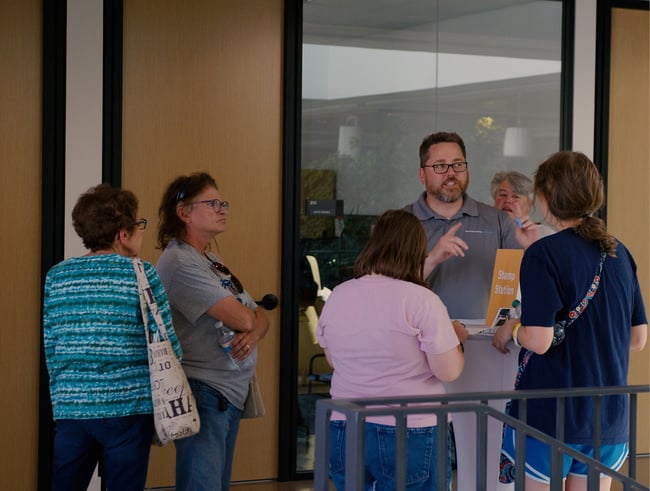The Stanley Center for Peace and Security Opens Its New Headquarters

Last month, the Stanley Center for Peace and Security opened its new headquarters to the public. The completed building in downtown Muscatine is designed to meet the standards of the Living Building Challenge (LBC)—the most rigorous measure of sustainable design.
Fully certified Living Buildings generate all their energy through on-site renewables, collect and recycle their water, and provide healthy, equitable, and beautiful spaces for their occupants. Certification occurs after the building’s first operational year, and if all goes to plan, the Stanley Center will be one of 35 Certified Living buildings in the world.
To celebrate this achievement, the Stanley Center hosted a Sustainability Fair and dedication ceremony on the weekend of June 3rd. This article will highlight some of the key moments from these events.
Sustainability Fair
The Stanley Center’s first event, the Sustainability Fair, occurred on Friday, June 2nd. The fair, which had over 2,000 attendees, included self-guided tours of the building and opportunities to learn about its sustainable features from the team at Neumann Monson and Graham Construction.
For Muscatine residents, this was an exciting chance to revisit a community landmark. Before the renovation, the building housed the Musser Public Library. Reusing the structure reduced embodied carbon emissions and helped revitalize a prominent corner lot in downtown Muscatine.

Visitors had the chance to learn about sustainable features from the NM team.
Outside, more than 30 community organizations—including the Muscatine Art Center and the Muscatine Center for Social Action—gathered to engage the community and share information about sustainable practices.
The fair also included performances from West Liberty High’s Los Cometas Mariachi Band, Calvary Church’s African Choir, and drag entertainers from across the state.
Dedication Ceremony
The following evening, the Stanley Center hosted a dedication ceremony within the building’s flexible lobby space. Since 1956, the Stanley Center has worked to find solutions to global challenges like nuclear armament, mass violence and atrocities, and climate change.
The dedication ceremony was an opportunity to bring together the Stanley Center’s past and current partners and share its vision for the future.
After opening remarks from Vice President Mark Seaman, the event kicked off with a pre-recorded address from Dr. Hilda Heine, the former President of the Republic of Marshall Islands.
Island nations are some of the most vulnerable to the threats of climate change. Rising sea levels, expected to increase 20 inches over the next 30 to 50 years, will make many islands around the globe inhabitable. For Dr. Heine, the Stanley Center’s new headquarters serves as a teaching tool for others, showing how sustainable solutions can be scaled.
The ceremony also included remarks from Robert Orr. Orr has been a friend and ally of the Stanley Center for decades and now serves as the Special Advisor to the UN Secretary-General on Climate Change and the Dean of the School of Public Policy at the University of Maryland.
His remarks emphasized the importance of collective action. Climate change is the greatest existential threat to humanity, and no one can afford to be dispassionate.
Although we are far from winning the battle, progress has been made through steps like the Paris Climate Change Agreement. As we move forward, we will need to leverage our diversity and cultivate a collective vision.
Echoing this message was Elizabeth Nyamayaro, the event’s final speaker. Nyamayaro is an activist, author, and Special Advisor to the UN World Food Program. She is also the head of HeForShe, a solidarity movement for global gender equality.
In her speech, Nyamayaro described her childhood in post-colonial Zimbabwe and the lessons she learned from her grandmother. Specifically, she discussed the concept of Ubuntu, meaning “I am because we are.”
The concept encourages us to recognize the shared humanity in everyone. What impacts one person impacts us all.
This interconnected worldview offers a path forward when facing threats like climate change. No one lives in isolation, and we need to recognize our role in the global community and take responsibility for the well-being of all.
The Living Building Challenge provides a way for individuals to take responsibility. Buildings account for nearly 40% of global greenhouse gas emissions. By changing the way we design, construct, and operate our buildings, we can begin to tackle one of the many contributors to climate change.
Learn More About the Stanley Center for Peace and Security
For the Stanley Center’s President and CEO, Keith Porter, the newly completed headquarters is a chance to “walk the talk.” As an organization dedicated to addressing issues like climate change, the Stanley Center wanted to use this project to embody its mission and values.
The building also serves as an educational tool—a model for sustainability that encourages others to consider how design and construction can make the world a better place. The Sustainability fair and the dedication ceremony were opportunities to share that vision on a local and global level.
Educational opportunities are one of the many components of the Living Building Challenge. Learn more about the LBC’s requirements by reading about its seven petals.